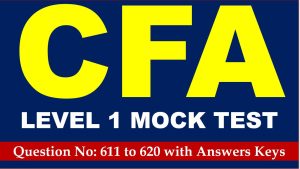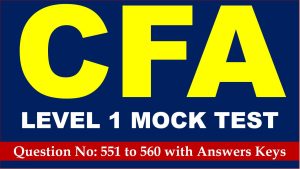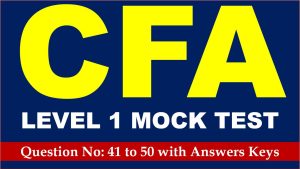Hi CFA Aspirants, welcome to AKVTutorials. Are you preparing for CFA Level 1, 2, 3 exams for making a career in CFA (Charted Financial Analyst). According to CFA Wikipedia, CFA The Chartered Financial Analyst (CFA) program is a postgraduate professional certification offered internationally by the American-based CFA Institute. A candidate who successfully completes the program and meets other professional requirements is awarded the “CFA charter” and becomes a “CFA charter holder”. Therefore, you need CFA Study Notes and Free CFA Level 1 Test 42 Practice Sample Questions Answer Keys AMBIPi
In this article, you will get Free CFA Level 1 Mock Exam Practice Questions.
Free CFA Level 1 Mock Practice Exam Questions Bank
Free CFA Level 1 Practice Question No: 411:
What deposit would you need to make today in order to withdraw $200 a month, beginning next month, for the next 5 years, if the deposit will accrue interest at 8% per year, compounded monthly?
Option A: $7,237.66.
Option B: $9,863.69.
Option C: $11,492.59.
Option D: $8,399.27.
Option D: $9,141.23.
Show/Hide Answer
Option B : $9,863.69.
On the BAII Plus, press 60 N, 8 divide 12 = I/Y, 200 PMT, 0 FV,
CPT PV. On the HP120, press 60 n, 8 ENTER 12 divide i, 200
PMT, O FV, PV. The answer will be displayed as a negative number. Make sure the BAII Plus has the value of P/Y set to 1.
CFA Level 1 Exam Question No: 412:
What is a Type II error?
Option A: Rejecting a false alternative hypothesis.
Option B: Accepting a false null hypothesis.
Option C: None of these answers
Option D: Accepting a false alternative hypothesis
Option E: Rejecting a false null hypothesis.
Show/Hide Answer
Option B : Accepting a false null hypothesis.
The type II error is accepting the null hypothesis when it is actually false.
Free CFA Level 1 Mock Exam Question No: 413:
What is the variable used to predict another variable called?.
Option A: Important.
Option B: Causal
Option C: Independent.
Option D: None of these answers.
Option E: Dependent.
Show/Hide Answer
Option C : Independent.
The dependent variable is the variable Y which is being predicted by the X variable, the independent variable. The regression is written as Y’ = a + bX. The letter “a” is the Y intercept and b is the
slope of the line. Y’ is the predicted value of Y given a specific value of X.
CFA Level 1 Free Practice Question No: 414:
If you deposit $345 into an account paying 5.45% per year simple interest, how much interest will be earned after 10 months?
Option A: $15.67.
Option B: $360.67.
Option C: $188.03.
Option D: $359.59.
Option E: $14.59.
Show/Hide Answer
Option A : $15.67.
The question only asks for the earned interest, not the total amount in the account. On the BAll Plus, press 345 × 0.0545 × 10 divide 12 = to see the answer. On the HP12C, press 345 ENTER 0.0545 × 10 12 divide to see the answer.
Free CFA Practice Question No: 415:
You have set up a test of a suitably phrased null hypothesis. After analyzing the statistical underpinnings of the test and the stringency requirements you have imposed, you have determined that the probability of rejecting the null hypothesis equals 30%. The probability that you will reject the null hypothesis when it is true is equal to 13% and the probability that you will reject the null hypothesis when is false is equal to 17%. The significance level of your test equals ____________.
Option A: 17%.
Option B: 6%.
Option C: 30%.
Option D: 13%.
Show/Hide Answer
Option D : 13%.
The significance level equals the probability of making a Type I error, which is the error of rejecting the null when it is, in fact, true. In this case, this has been given to be equal to 13%.
CFA Level 1 Sample Question No: 416:
A study of business faculty at state supported institutions in Ohio revealed that the mean salary for nine months is $52,000 and the standard deviation of the sample is $3,000. The study also showed that the faculty had been employed an average (mean) of 15 years with a standard deviation of 4 years. How does the relative dispersion in the distribution of salaries compare with that of the lengths of service?
Option A: Salaries about 6%, service about 27%.
Option B: Salaries about 100%, service about 50%.
Option C: Salaries about 2%, service about 6%.
Option D: None of these answers.
Option E: Salaries about 42%, service about 81%.
Show/Hide Answer
Option A : Salaries about 6%, service about 27%.
The coefficient of variation = (s*100/mean. Salary: 3,000*100/52,000 = 5.7%. Service: 4*100/15 = 26.7%.
Free CFA Level 1 Quiz Question NO: 417:
When comparing the riskiness of investments with different expected returns, one must use __________.
Option A: none of these answers.
Option B: skewness.
Option C: the coefficient of variation.
Option D: the standard deviation.
Option E: kurtosis.
Show/Hide Answer
Option C : the coefficient of variation.
The coefficient of variation equals the ratio of the standard deviation to the mean. Thus, it standardizes the variation in the returns in terms of the expected values.
Free CFA Level 1 Quiz Question NO: 418:
According to Chebyshev’s Theorem, what percent of the observations lie within plus and minus 1.75 standard deviations of the mean?
Option A: Cannot compute because it depends on the shape of the distribution.
Option B: 56%.
Option C: 95%.
Option D: 67%.
Option E: None of these answers.
Show/Hide Answer
Option D : 67%.
Chebyshev’s theorem applies regardless of the shape of the distribution. The minimum proportion that lie within k standard deviations of the mean is at least 1-[1/ (k^2)]. In this case k = 1.75. k^2 = 3.0625. So we get 67%.
Free CFA Practice Question No: 419:
_______ states the range over which a population parameter likely lies.
Option A: A point estimate
Option B: A normal deviate.
Option C: A confidence interval.
Option D: A stratified range estimate.
Show/Hide Answer
Option C : A confidence interval.
A confidence interval gives a range of values within which there is a high probability that the population parameter occurs.
CFA Mock Exam Free Question No: 420:
In graphs of return performance, which of the following scales is commonly used?
Option A: Exponential scale.
Option B: Semi-logarithmic scale.
Option C: Arithmetic scale.
Option D: Log-normal scale.
Show/Hide Answer
Option B : Semi-logarithmic scale.
Historical returns are often graphed using a semi-logarithmic scale, where equally-large y-axis movements correspond to equally-large percentage changes. An arithmetic scale, on the other hand, has equally-large y-axis movements corresponding to equally-large arithmetic changes. So on an arithmetic scale, the vertical movement for a price change from 100 to 110 is just as large as the vertical movement from 10,000 to 10,010. This is widely considered a distortion (if you are considering rates of return), so the semi
-logarithmic scale is used instead.



